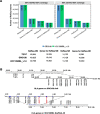Personalized genome assembly for accurate cancer somatic mutation discovery using tumor-normal paired reference samples
- PMID: 36352452
- PMCID: PMC9648002
- DOI: 10.1186/s13059-022-02803-x
Personalized genome assembly for accurate cancer somatic mutation discovery using tumor-normal paired reference samples
Abstract
Background: The use of a personalized haplotype-specific genome assembly, rather than an unrelated, mosaic genome like GRCh38, as a reference for detecting the full spectrum of somatic events from cancers has long been advocated but has never been explored in tumor-normal paired samples. Here, we provide the first demonstrated use of de novo assembled personalized genome as a reference for cancer mutation detection and quantifying the effects of the reference genomes on the accuracy of somatic mutation detection.
Results: We generate de novo assemblies of the first tumor-normal paired genomes, both nuclear and mitochondrial, derived from the same individual with triple negative breast cancer. The personalized genome was chromosomal scale, haplotype phased, and annotated. We demonstrate that it provides individual specific haplotypes for complex regions and medically relevant genes. We illustrate that the personalized genome reference not only improves read alignments for both short-read and long-read sequencing data but also ameliorates the detection accuracy of somatic SNVs and SVs. We identify the equivalent somatic mutation calls between two genome references and uncover novel somatic mutations only when personalized genome assembly is used as a reference.
Conclusions: Our findings demonstrate that use of a personalized genome with individual-specific haplotypes is essential for accurate detection of the full spectrum of somatic mutations in the paired tumor-normal samples. The unique resource and methodology established in this study will be beneficial to the development of precision oncology medicine not only for breast cancer, but also for other cancers.
© 2022. The Author(s).
Conflict of interest statement
CP was employed by Dovetail Genomics, LLC, and LF was employed by Roche Sequencing Solutions Inc during the course of this research. The other authors declare that they have no competing interests.
Figures








Similar articles
-
PRESM: personalized reference editor for somatic mutation discovery in cancer genomics.Bioinformatics. 2019 May 1;35(9):1445-1452. doi: 10.1093/bioinformatics/bty812. Bioinformatics. 2019. PMID: 30247633
-
Consistency and reproducibility of large panel next-generation sequencing: Multi-laboratory assessment of somatic mutation detection on reference materials with mismatch repair and proofreading deficiency.J Adv Res. 2023 Feb;44:161-172. doi: 10.1016/j.jare.2022.03.016. Epub 2022 Mar 31. J Adv Res. 2023. PMID: 36725187 Free PMC article.
-
Precise characterization of somatic complex structural variations from tumor/control paired long-read sequencing data with nanomonsv.Nucleic Acids Res. 2023 Aug 11;51(14):e74. doi: 10.1093/nar/gkad526. Nucleic Acids Res. 2023. PMID: 37336583 Free PMC article.
-
Haplotyping-Assisted Diploid Assembly and Variant Detection with Linked Reads.Methods Mol Biol. 2023;2590:161-182. doi: 10.1007/978-1-0716-2819-5_11. Methods Mol Biol. 2023. PMID: 36335499 Review.
-
Detecting Somatic Mutations in Normal Cells.Trends Genet. 2018 Jul;34(7):545-557. doi: 10.1016/j.tig.2018.04.003. Epub 2018 May 3. Trends Genet. 2018. PMID: 29731376 Free PMC article. Review.
Cited by
-
A multiomic characterization of the leukemia cell line REH using short- and long-read sequencing.Life Sci Alliance. 2024 May 22;7(8):e202302481. doi: 10.26508/lsa.202302481. Print 2024 Aug. Life Sci Alliance. 2024. PMID: 38777370 Free PMC article.
-
Genome assembly resources of genitourinary cancers for chromosomal aberration at the single nucleotide level.Sci Data. 2025 Apr 1;12(1):550. doi: 10.1038/s41597-025-04801-7. Sci Data. 2025. PMID: 40169664 Free PMC article.
-
Clinical and analytical validation of a combined RNA and DNA exome assay across a large tumor cohort.Commun Med (Lond). 2025 Jun 16;5(1):236. doi: 10.1038/s43856-025-00934-3. Commun Med (Lond). 2025. PMID: 40523952 Free PMC article.
-
From Samples to Germline and Somatic Sequence Variation: A Focus on Next-Generation Sequencing in Melanoma Research.Life (Basel). 2022 Nov 21;12(11):1939. doi: 10.3390/life12111939. Life (Basel). 2022. PMID: 36431075 Free PMC article. Review.
-
Evaluation of somatic copy number variation detection by NGS technologies and bioinformatics tools on a hyper-diploid cancer genome.Genome Biol. 2024 Jun 20;25(1):163. doi: 10.1186/s13059-024-03294-8. Genome Biol. 2024. PMID: 38902799 Free PMC article.
References
Publication types
MeSH terms
Grants and funding
LinkOut - more resources
Full Text Sources
Medical

